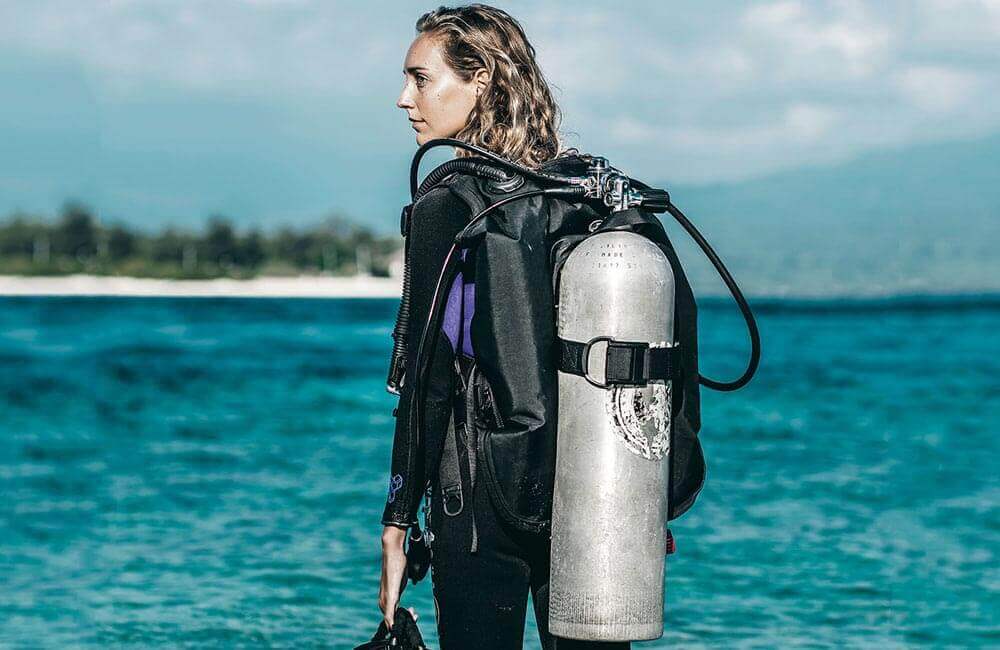
As the lines between technical and recreational diving start to blur, Mark ‘Crowley’ Russell takes a look at some technically inspired back-inflation BCDs
The last decade has seen a steady growth in the exposure of technical diving to the much more populous recreational diving community. It was not so very long ago that the former was something of a mystery to the latter. However, technical diving has gained much more recognition within the recreational world, partly due to the availability and popularity of courses such as the PADI/DSAT TecRec programmes, designed to promote technical expertise as a natural progression from recreational diving.
The presence of technical gear in dive centres has become more commonplace, and with it, conversations about its benefits – particularly with regard to the backplate and wing (BP/W) designs that technical divers espoused over the classic jacket (or vest) style BCDs. Given that almost every recreational diver learned to dive wearing a jacket-style BCD, many are therefore hesitant to invest in a BP/W given that these are still mostly regarded as the preserve of technical divers. Back-inflation BCDs offer a good alternative, a cross between the traditional jacket and the fully fledged wing designs.
The concept of back-inflation design BCDs is not new, and nowadays almost every manufacturer has at least one model available, with some variation on the theme. In short, they have the adjustable harnesses commonplace to jacket-style BCDs, often with integrated weight systems, but all the lift is generated by a bladder which is situated behind the diver.
Pros and cons of back-inflation BCDs
The biggest advantage of a back-inflation BCD over a traditional jacket is the ability to maintain better horizontal positioning under the water. With the bladder to the rear of the diver, the distribution of air is much more even than it is in a jacket-style BCD. The design does not guarantee perfect trim, however. Overweighting and uneven weight distribution will pull a diver out of position regardless of the style of BCD they are wearing, but nevertheless, back-inflation provides a much more level starting point.
Back-inflation BCDs have less bulk around the sides and chest area, which serves several purposes. Anything that reduces a diver’s profile in the water reduces drag and improves streamlining. Swimming is therefore a little easier, which potentially leads to improved air consumption. Many divers feel that the harness is more comfortable to wear. Jacket BCDs can feel very tight when fully inflated at the surface, often meaning that divers adjust the buckles to reduce discomfort, but as a result, the harness is too loose once the BCD is deflated. This means buoyancy control becomes more difficult unless the harness is tightened, whereupon it may become uncomfortable back at the surface.
Probably the biggest downside to back-inflation BCDs is their propensity to push a diver face-forward at the surface. Faceplanting is easy to avoid, but it takes a bit of practice and can be quite frustrating for novice divers.
The lack of pockets on certain models is also viewed by some as a problem, but this is really only a matter of convenience. Torches, reels and SMBs and other typical dive equipment items are easily re-located and mountable on D-Rings. Accessory pockets are widely available.
Apeks Black Ice £582

The Apeks Black Ice is ‘designed with the advanced diver in mind’, a back-inflation BCD ‘crossing over into technical, military and public safety applications’, according to Apeks. The bespoke ‘Wrapture’ harness allows divers to pick components from each of the three available sizes in order to tailor the size of the harness to their needs. The Black Ice can be rigged for twin cylinders with an optional twin-cylinder kit. The bladder is constructed of 840-denier nylon, providing up to 24kg of lift, features a retraction system to keep the bladder streamlined, and comes with four dump valves. Five large stainless-steel D-rings, knife-mounting points, one large folding and one zip pocket provide for accessory storage. The integrated weight system can hold up to 14.5kg of lead, with trim pockets to the rear adding up to 4.5kg more.
Specifications
Dry weight: 4.4kg
Maximum lift: 24kg
Backplate: rigid
Integrated weights: yes
www.apeksdiving.com
AP Diving Travelwing £330

The AP Travelwing is a back-inflation style BCD that comes with an integrated weight system as standard, the pockets of which can be extended and used for storage if the diver prefers to use a weight belt. The cummerbund is adjustable at both the front and rear, and the soft backplate is padded for extra comfort, but no twinset cam upgrade is available. D-rings are plentiful, with a total of seven on the outside and one on each pocket. Divers looking for a more versatile BCD may prefer to the AP Tekwing, which has a rigid backplate, twinset cam-band upgrade, 27.5kg of lift and a range of optional accessories, priced at £352.
Specifications
Dry weight: 2.7kg(S/M) – 2.9kg(L/XL)
Maximum lift: 14.5kg
Backplate: soft
Integrated weights: yes
Aqua Lung Rogue £455

According to Aqua Lung, the Rogue is ‘created for the accomplished diver who knows exactly what gear they want’, and it definitely lives up to the description of ‘minimal design’. The ‘ModLock’ connectors allow all parts of the back-inflation BCD and its associated accessories to be interchanged, creating 27 possible sizes of harness, to cater for different sizes of diver. The three-position bladder retraction system keeps the bladder compact during deflation, integrated ‘SureLock II’ weight pockets come as standard, along with two folding storage pockets and four stainless-steel D-rings – as Aqua Lung says: ‘Everything you need without any of the faff’. Trim pockets, and SMB pocket and waistband extender, are available as optional extras.
Specifications
Dry weight: 2.2kg
Maximum lift: 15kg
Backplate: soft
Integrated weights: standard
Cressi Commander £461
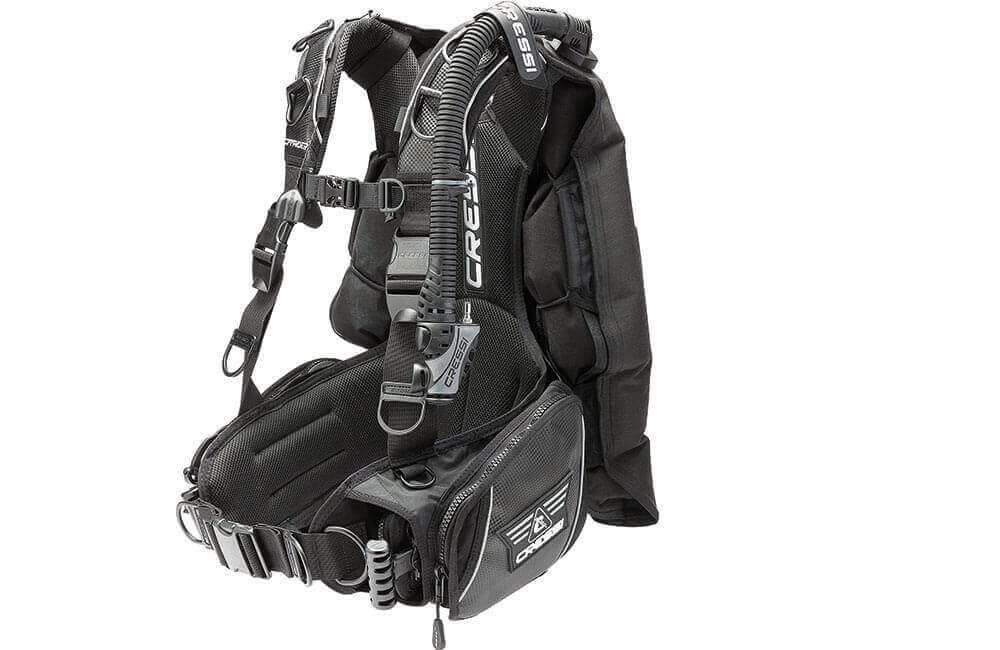
Cressi’s Commander is a redesign of the Back Jac, separating the harness entirely from the bladder, adding an integrated quick-release weight system with two roomy storage pockets to the outside, and removable tank strap weight pouches to the rear. The bladder is elasticated, ensuring it remains as compact as possible, built around a semi-rigid backpack. Four large D-rings are available on the shoulder straps and four smaller D-rings are affixed to the pockets and the bottom of the harness. The Commander back-inflation BCD is only available in shops and not online. Divers looking for a lighter (2.75kg), but less versatile back-inflate BCD might like to consider the Cressi Patrol at £293.
Specifications
Dry weight: 3.25kg (size M)
Maximum lift: 19kg (size M)
Backplate: semi-rigid
Integrated weights: yes
Hollis HD200 £499

Hollis is very much geared towards technical diving, with its backmount range consisting only of rear-inflation models, plus backplate and wing designs. The HD-200 is specifically designed for the tech/rec market, with its fully adjustable harness, including quick-release cummerbund and crotch strap, and sternum strap with two chest-mounting points and quick-release shoulder straps. A total of eight D-rings are included, two on the shoulders, two on the hips and four to the rear. Two 4.5kg interchangeable quick-release weight pockets and two 2.3kg non-ditchable rear weight pockets are included.
Specifications
Dry weight: 4.3kg
Maximum lift: 16kg (size S/M), 24kg (size L/XL)
Backplate: rigid
Integrated weights: yes

Mares Pure SLS £311

The Pure SLS has been around for a few years, as well-designed products tend to be. Built from 420-denier nylon, the Pure SLS has a backpack with a rigid ‘monoplate’ that allows the diver the option of fitting double tanks. The waist strap has a clamp buckle (like a weight belt) as opposed to pinch clips, allowing for a wide range of adjustment. Integrated weight pouches with a visual confirmation of insertion come as standard, along with two rear trim pockets. Seven stainless-steel D-rings and a roll-down pocket are available for storage. Divers looking for a lightweight travel option, but with less overall versatility, may be tempted by the new Magellan, priced at £266
Specifications
Dry weight: 3.8kg (size L)
Maximum lift: 21kg (size L)
Backplate: rigid
Integrated weights: yes
Oceanic Excursion £439.95

Designed for both recreational and technical diving, the Oceanic Excursion generates up to 26kg of lift in the larger sizes, thanks to a generous, and rugged, 1,400-denier bungeed bladder. The QLR4 integrated weight pockets hold up to 9kg with zippered cargo pockets on each side, plus dual 2kg trim pockets to the rear. Eight pre-bent stainless-steel D-rings are available for mounting and accessories, and Oceanic offers an Air XS2 alternate air source inflator as an optional extra.
Specifications
Dry weight: 4.0kg
Maximum lift: 20.4kg (size S/M), 26kg (size L/XL)
Backplate: rigid
Integrated weights: yes
Scubapro Seahawk 2 £429

A 2019 update to Scubapro’s popular Seahawk, the Seahawk 2 is very much a recreational BCD in terms of both style and function, but provides an impressive 24kg of lift. Constructed with 1,000- and 420-denier nylon, the Seahawk 2 has integrated weight pockets and two rear trim pouches as standard, with two large cargo pockets occupying the sides of the BCD.. Six large and two small stainless-steel D-rings allow for maximum carrying capacity, and the Seahawk 2 is available with either a standard power inflator or AIR2. Divers seeking a more minimalist, but fully customisable design – without the cargo pockets – may wish to check out the modular Hydros Pro, priced at £629
Specifications
Dry weight: 3.2kg (S) – 3.5kg(XXL)
Maximum lift: 24.4kg
Backplate: rigid
Integrated weights: standard
SEAC Modular £375
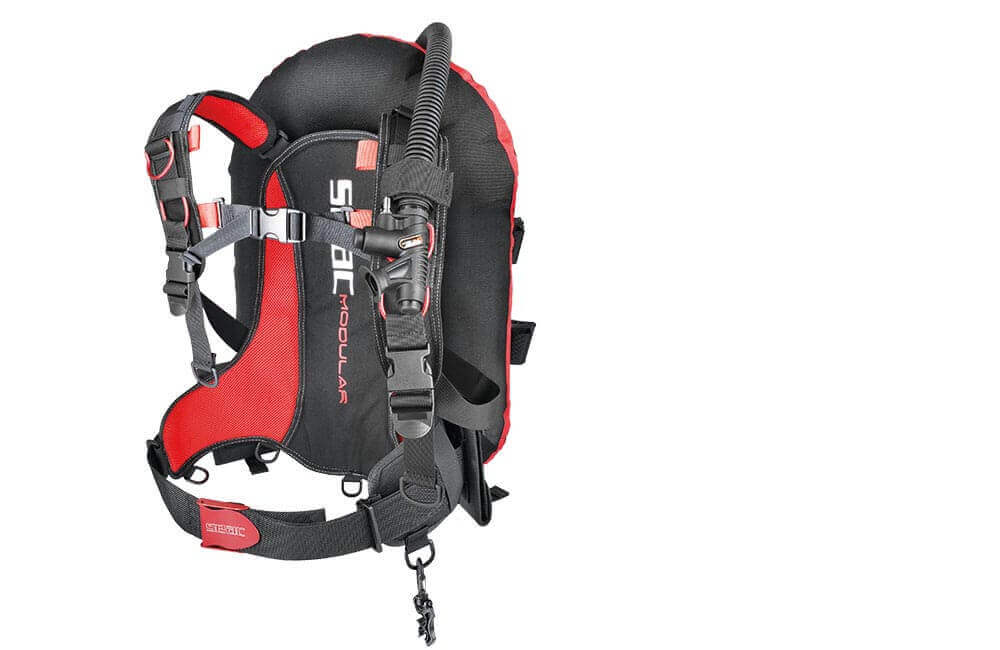
Launched in 2018. the SEAC Modular is as close to being a backplate and wing as it’s possible to get without buying an actual backplate and wing. The harness, backplate and doughnut-shaped bladder are all interchangeable, and a range of accessories can be added as desired. The steel core of the backplate can be removed to make an extremely lightweight and flexible travel option (an aluminium core is also available). A quick-release weight system comes as standard; trim pockets and cargo pockets are available as optional extras, in a BCD with a harness that is designed to fit all sizes of diver.
Specifications
Dry weight: 2.9kg
Maximum lift: 13.6kg
Backplate: soft with removable rigid core
Integrated weights: yes
TUSA BCJ-8000 X-Wing €569
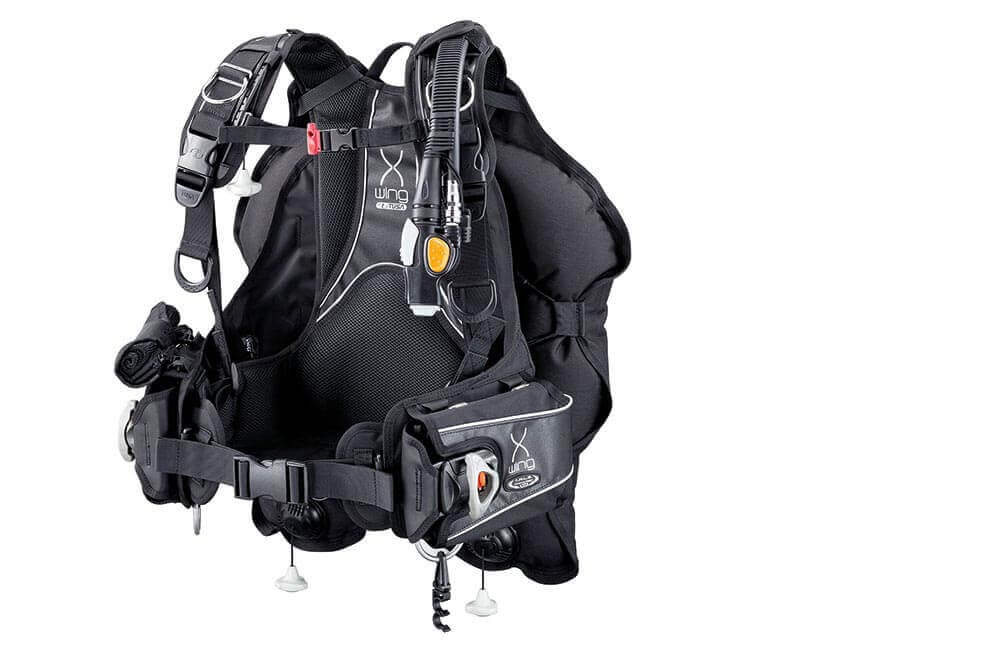
The X-Wing back-inflation BCD from TUSA features an independent harness and horseshoe-shaped bladder and bungee constructed from 500-denier nylon, with added foam padding and a ‘depthcompensating’ cummerbund built in for added comfort. Integrated weights and two removable, rear trim pockets come as standard, along with two stainless steel and three resin D-rings, knife-mounting grommets and – unusually – four dump valves. The X-Wing is currently unavailable in the UK.
Specifications
Dry weight: 3.5kg
Maximum lift: 13.3kg (size S/M) – 18.4kg (L/XL)
Backplate: soft
Integrated weights: yes
ZeagleCovert XT £339
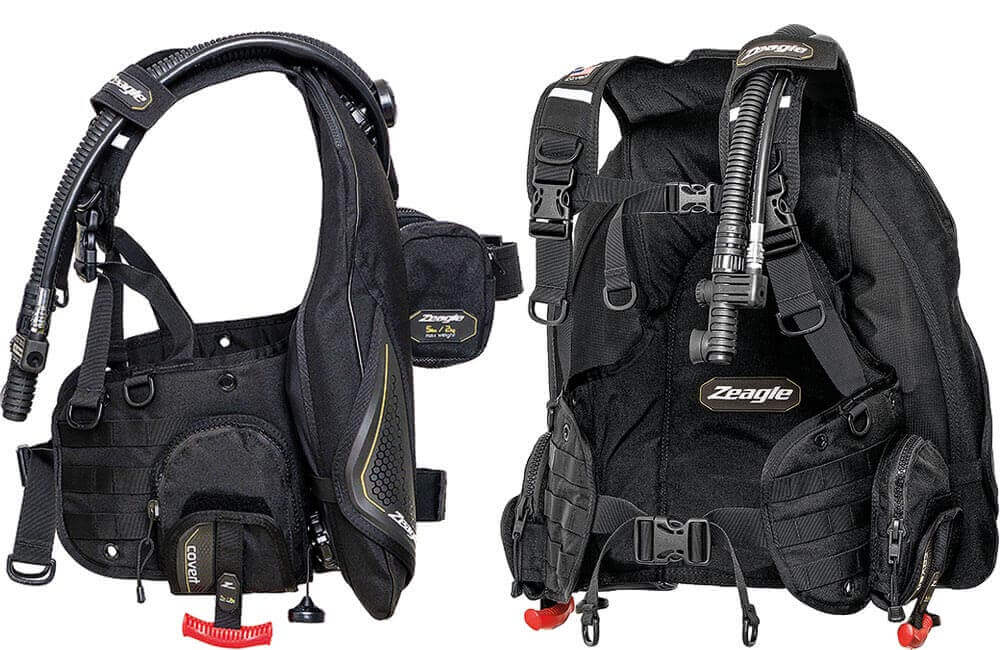
The lightweight Covert XT is designed with the travelling diver in mind, weighing in at just 2.3kg dry, with a new front vest constructed of 1,000-denier nylon, a new accessory attachment system, and extra padding at the shoulders and for lumbar support. The large weight pockets can each take up to 6kg of lead, with a redesigned quick-release system, and tank-strapmounted trim pockets holding up to 2kg each are included as standard. Four plastic D-rings complete the ensemble, with a lifting capacity of up to 19kg. The Covert XT is available with Zeagle’s Octo-Z combination regulator and inflator as an optional extra.
Specifications
Dry weight: 2.3kg
Maximum lift: 15.4kg (size XS-M) – 19kg (size L-XL)
Backplate: soft
Integrated weights: yes
Technical diving with a back-inflation BCD
Although the design of back-inflation BCDs has its roots in technical diving, whether or not they can be used for technical diving is a different question. Having said that, ‘technical diving’ is a very broad umbrella term for a range of activities. Tech diving doesn’t have to be deep – it could mean simply extending bottom time at 30m to explore the extent of a particularly pleasant reef. In this case, many models of back-inflation BCD will suffice, although models with a high lift capacity and twin-tank configuration may be preferable.
For more advanced technical diving, however – including greater depths, cave and wreck penetration – the average back-inflation BCD is not sufficient. High-capacity wings designed specifically for such activities are the only option for such diving.
With that in mind, the ‘half-and-half ’ design of back-inflate BCDs is targeted at those who have learned enough to progress beyond the limits of recreational diving, but have no real desire to reach the limits of technical diving. They take the best from both worlds, allowing divers to explore the increasingly blurred lines between recreational and technical diving.
Buying tips
As with all scuba diving equipment where size is important, trying before buying is highly recommended. BCD sizes can vary dramatically from clothing sizes, and it’s not unusual for a diver who wears XL-sized T-shirts to require only a medium-sized BCD. This depends to a large extent on whether or not you’ll be diving in a thin suit in warm water, or wearing a heavy drysuit in cold water.
If you’re content to take advantage of the technical aspects of a back-inflate jacket in a purely recreational setting, then which model you choose might simply come down to style and price. If you plan to explore the world of tech/rec, a model with a high-lift capacity and twin-tank capability would be a worthwhile investment.
Different styles of BCD
BCD (Buoyancy Control Device) – or BC (Buoyancy Compensator) – is a coverall term for the apparatus that allows divers to sink, float, or establish neutral buoyancy underwater as necessary. It’s often the case that the terms are used to refer specifically to jacket-style equipment, which is something of a misnomer. Wings and stabilisation (stab) jackets are BCDs as much as vests, hybrids, and back-inflation designs.
JACKET/VEST: The most common style of BCD, almost universally present as rental gear within the recreational scuba diving industry, is the ‘jacket’, ‘vest’ or sometimes ‘wraparound’ style of BCD. An easily adjustable harness and backpack is fixed to an inflatable bladder providing buoyancy at both the rear and the sides of the diver’s body. Most current models of jacket have an integrated weight system and storage pockets built into the design. Jacket style BCDs are great for surface stability and are familiar to all divers, but it’s a little less easy to establish horizontal trim, they can impede arm movement and can be tight around the torso when inflated.
BACKPLATE/WING: The BP/W configuration is comprised of three separate components – a fixed backplate (usually steel or aluminium) to which the tank is attached, an inflatable bladder (the wing), most commonly an oval (‘doughnut’) or horseshoe shape for lift, and a harness to strap it to the diver’s body. The harness has less room for adjustment while being worn than a jacket-style BCD, and is complemented by a crotch strap, ensuring it does not slip out of position. The wing and backplate can be swapped to cater for different tank and weighting requirements. Less encumbrance around the shoulders and waist makes it easier for divers to accomplish tasks, or carry additional bulky equipment.
HYBRID: A cross between back-inflate and jacket style BCDs, hybrids have most of the lift generated by an air cell mounted behind the diver, but with smaller bladders at the sides. This helps to improve horizontal position underwater, but without the face-planting at the surface.
SIDEMOUNT: A departure from the classic diving style in which tanks are mounted on the diver’s back, sidemount allows divers to wear their tanks under each arm to minimise the profile of the diver underwater, especially useful for navigating tight spaces when cave or wreck diving. The BCD is much less bulky than all other designs, but the purchase of a sidemount configuration should not be undertaken without training.



